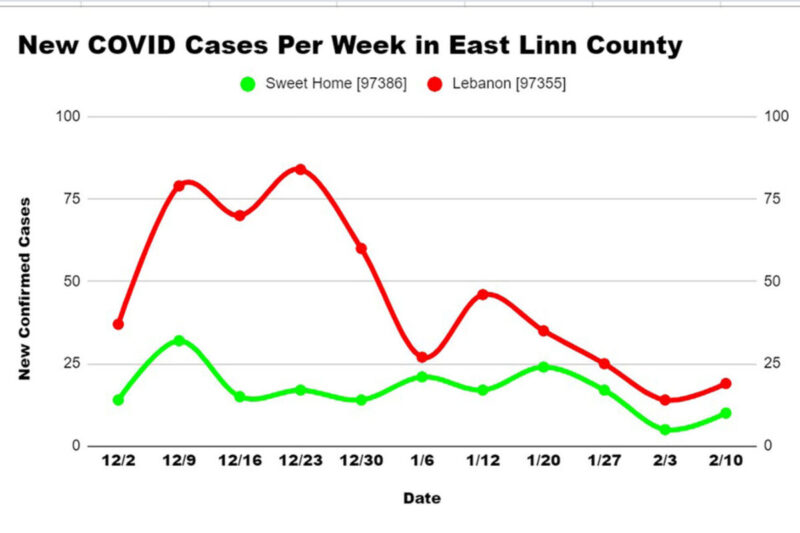Benny Westcott
As the next wave of local students heads back to brick-and-mortar classrooms this week, Linn County’s COVID numbers continue to drop.
During the week of Feb. 7 – Feb. 13 saw 88 new COVID cases reported in Linn County. By comparison, the county reported 211 cases of COVID during the two-week period from Jan. 24 to Feb. 6. That means the county is on pace to report 35 fewer cases of COVID during this two- week period compared to the last one.
If next week’s data were to replicate this week’s numbers, that would put Linn County at 131 cases of COVID per 100,000 people for the two-week period. Tracking where county COVID numbers fall in two-week increments, rather than in other time frames is important, because that is how Oregon determines what risk category a county falls under.
Even if this week’s numbers are similar to last week’s and the county experiences a drop in new cases per 100,000 people, that number would have to drop significantly further in order for Linn County to move into a new risk category.
Linn County is currently classified in the “high” risk category, because the county’s new COVID cases over 14 days have been landing in the 100- to 200-per-100,000 people range. In order to move into the “moderate” risk category, Linn County cases would have to fall to 50- to 100-per-100,000 people over a 14-day period, which means they would have to drop roughly 150% from the rate recorded in the Jan. 24 to Feb. 6 time frame.
But this past week’s numbers are a step in that direction, as they put the county on pace to make up more than half the difference between 166.7 and 100, 100 being the threshold of new cases per 100,000 people that would put the county in the moderate risk category.
In the “high” risk category in which Linn County is currently classified, indoor capacity is not to exceed 25% maximum occupancy or 50 people, whichever is smaller, for dining, entertainment, and recreation and fitness establishments.
At “moderate” risk, capacity can double those same establishments. Maximums for outdoor dining and the number of people allowed per table also increase. Capacity in churches, funeral homes and related facilities doubles from a maximum of 75 to 150 as risk drops from “high” to “moderate.”
Meanwhile, the Oregon Health Authority reported Monday, Feb. 15, that Oregon has now administered a “preliminary” cumulative total of 683,887 first and second doses of COVID-19 vaccines. To date, 885,250 doses of vaccine have been delivered to sites across Oregon. Those “preliminary” numbers are subject to change, the OHA cautioned.
Cumulative daily totals can take several days to finalize because providers have 72 hours to report doses administered and technical challenges have caused many providers to lag in their reporting. OHA has been providing technical support to vaccination sites to improve the timeliness of their data entry into the state’s ALERT Immunization Information System (IIS).
Linn County has reported 3,499 total coronavirus cases as of Monday, with 54 deaths attributed to the virus.
The OHA announced on SAturday that four “breakthrough” cases of COVID-19 had been detected, in which individuals tested positive for COVID-19 at least 14 days after completing their vaccination series.
Two of the cases are in Yamhill County and two are in Lane County.
OHA is working with local public health officials to investigate the origin. Their illnesses range from asymptomatic to mild symptoms. Results of the investigation are expected this week, the OHA said.
Such cases are not unexpected, according to an OHA statement.
“Clinical trials of both vaccines presently in use included breakthrough cases. In those cases, even though the participants got COVID-19, the vaccines reduced the severity of illness.”
Based on what is known about vaccines for other diseases and early data from clinical trials, OHA experts believe the existing vaccines are very effective, the statement said.





